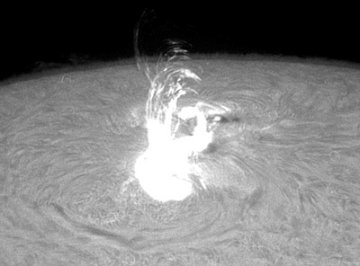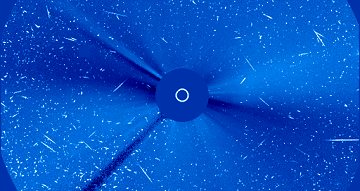 Would you like a call when auroras are brewing over your hometown? Sign up for SpaceWeather PHONE.
Would you like a call when auroras are brewing over your hometown? Sign up for SpaceWeather PHONE.
AURORA ALERT: If you live in northern places such as Alaska, Scandinavia or Canada, watch the skies around local midnight. Mild geomagnetic storms are producing Northern Lights best seen at that time of night. These storms could intensify when coronal mass ejections from sunspot 798 hit--perhaps this weekend. Sky watchers everywhere should remain alert for auroras.
ACTIVE SUN: Solar activity is very high. Earth-orbiting satelites have detected seven X-class solar flares since Sept. 7th, including one X17-class monster-flare. NOAA forecasters say there's a 75% chance of more X-flares during the next 24 hours, possibly causing radio blackouts and radiation storms.

The source of all this activity is giant sunspot 798, shown above flaring brightly on Sept. 9th (photo credit: Birgit Kremer of Marbella, Spain). The sunspot has grown so large, you can now see it with the unaided eye--but never look directly at the sun. Try these safe solar observing tips.
more images: from F. Uytterhoeven-Meeus of Erps-Kwerps, Belgium; from Pavol Rapavy of Rimavska Sobota, Slovakia; from Andreas Murner of Bavaria, Germany; from Robert Arnold on the Isle of Skye, Scotland;
RADIATION STORM: An S2-class radiation storm is underway. Solar protons are streaming past Earth at nearly light speed. These particles were accelerated toward us by the recent explosions at sunspot 798.
Here on Earth's surface, we're safe from the protons, except perhaps in areas around Earth's magnetic poles. Astronauts onboard the International Space Station are safe, too, as long as they stay inside the station.

Satellites and robotic spacecraft are experiencing some minor problems. For example, the white specks in the coronagraph image (above) from the SOHO spacecraft are caused by protons striking the craft's digital camera, partially blinding the instrument.
One place you wouldn't want to be during the storm: walking around on the Moon!

